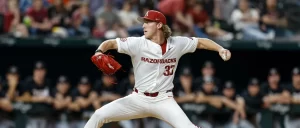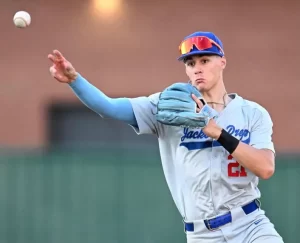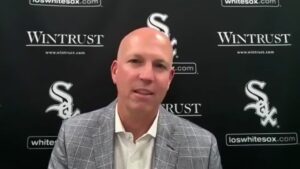2017 Draft Preview: OF Adam Haseley
We are writing prospect reports on players the White Sox might select in the June draft. We already posted a look at outfielder Jeren Kendall. This article is the second in our series.
Adam Haseley
School: University of Virginia
Position: Outfielder
Height/Weight: 6-1, 195 lbs
B/T: L/L
D.O.B: 4/12/1996
Previously Drafted: N/A
2017 Stats: .399/.496/.676 (1.172 OPS), 15 2B, 1 3B, 14 HR, 54 RBI, 10 SB, 41/20 BB/K
Scouting Reports:
“Haseley’s bat has taken a nice leap forward this season and he’s hit over .400 for much of his junior year. He uses the entire field and while he features more of an inside-out swing from the left side currently, an approach preached at Virginia because of the ballpark at home, there should be more pull side power to come. As it is, he’s showing more over-the-fence ability. While not a burner, Haseley does have above-average speed. He is capable of playing center field, but whether that’s his long-term home remains to be seen. He is capable of playing all three outfield spots, with at least an average arm.” – MLB Pipeline
“Haseley leads the Cavaliers in all three triple-slash stats (.396/.495/.689) and in walks (32) through April 22, showing surprising power and the potential to stay in centerfield long-term, though I don’t know that he’s going to have more than fringy power with the wood bat.” – ESPN, Keith Law (Insider)
Across-the-board tools and skills are the drawing cards here. Haseley is a fine overall-athlete with above-average running speed, a strong throwing arm, and defensive instincts that would work well at any outfield position. While his pure hitting skills have always been respected, he’s answered questions about his power by showing more thump this spring. – John Sickels, Minor League Ball
Scouting Grades (Via MLB Pipeline):
Hit: 55
Power: 45
Run: 55
Arm: 50
Field: 55
Overall: 55
Prospect Overview and Future Outlook:
If you’re looking for someone in the mold of the Alex Call and Jameson Fisher types the White Sox grabbed in the early rounds last year, then Virginia outfielder Adam Haseley is your guy. Haseley attended The First Academy in Florida and would have been more seriously on the draft radar out of high school had he not been so strongly committed to the University of Virginia. As a Commodore, Haseley has both hit at the top of the line up and pitched as Virginia’s coveted Friday night starter. That makes him a lesser known two-way player in this draft class, joining Brendan McKay and Hunter Greene.
Despite having a career 2.51 college ERA over 29 starts and 172 innings, Haseley doesn’t quite have the stuff to be looked at as a pro arm. His bat is not only more promising, but part of the banked upside is in the idea that he could improve even more once he focuses solely on being a position player. With the stick, Haseley has gradually improved each season at the collegiate level. He followed a mediocre freshman season with a Sophomore season that put him on the map, as he slashed .304/.377/.502 with 19 doubles, six triples, and six home runs. His Junior year has been his bonafide breakout though. Haseley sits 8th among the Division I ranks in batting average (.399) and 7th in OBP (.496). The reason Haseley’s shooting up draft boards however is an increase in power output that has revamped his entire profile. His ISO stands at .277 and he’s cranked out a career high 14 home runs.
While he doesn’t feature a toolbox overflowing with flashy tools, Haseley’s calling card is being firmly solid across the board. He has a very fluid swing with a pronounced leg kick that enables him to be explosive through his lower half. This is likely how he generates power, and from an admittedly brief sampling of videos, it looks like the leg kick is something he added in college. This mechanical change might explain the uptick in power or it’s a product of physical development, but either way Haseley doesn’t figure to have much projection left in his frame. Right now, it looks like a package that could deliver 12-15 HR power or at the very least gap doubles pop. He certainly doesn’t resemble a slap hitter, which means he could safely play in a corner. This was a significant question prior to his junior season, as some evaluators wondered if Haseley had the glove for center or more importantly the power to survive without it.
Haseley has the footspeed for center field and MLB Pipeline grades him above average defensively, citing that he’s “capable of playing all three outfield spots, with at least an average arm.” For all that’s been said about Haseley’s teammate and roommate Pavin Smith having more home runs than strikeouts, Haseley isn’t that far off from similar stature with 14 bombs and just 20 whiffs. His 0.49 K/BB speaks to his strong eye more than anything.
When it’s all synthesized, the overall package shakes out quite well. What Haseley lacks in ceiling, he makes up for in floor. A stable hit tool, competent glove in center, and playable speed (10/14 SB/ATT) make him one of the draft’s safer plays. He’s one of the most polished players in the draft field and as a college bat stands as one of the closest to the majors as well.
Draft Day:
Ahead of his Junior season at Virginia, Haseley was pegged as more of a 2nd or 3rd round pick and not necessarily lauded in the upper echelon of draft prospects. His rise is a byproduct of an emerging power stroke and a generally weak college position player crop. MLB Pipeline rates him as 14th overall, Baseball America ranks him 13th, and ESPN’s Keith Law has him ranked where the White Sox pick at #11. Mock drafts have been volatile, with Jim Callis’ most recent mock featuring Haseley 5th overall and the White Sox snagging Vandy outfielder Jeren Kendall at #11. Baseball America’s John Manuel’s latest projection has Haseley going to the Angels the pick before, and Kendall landing in Chicago’s lap. Keith Law has Haseley going to the Diamondbacks at number seven and the White Sox grabbing his teammate Pavin Smith.
Any way you draw it, there’s a real shot Haseley could be there for the White Sox at 11th overall. Most prognosticators have them in heavy on college bats and it does make a whole lot of sense. For as much is often written about the best-player-available approach, Chicago does sport a robust pitching pipeline. The draft stands as one of the best routes to infuse some more positional talent into the system. It’s also possible that a college bat will be the best player on the board anyway if prep stars like Jo Adell and Austin Beck have already found homes. Meanwhile, options are thin in a weak college pitching class and the White Sox have seldom dipped their toes into the prep arm waters.
So it really looks like a college bat and likely comes down to Kendall or Haseley by default, or in an even more intriguing development, the luxury of a choice between the two. The analytically driven pick would lean Haseley and that would be more in line with how Nick Hostetler approached last year’s draft. On the flip side, the allure of Kendall’s ceiling as a 20/20 style player with plus defense in center could be too hard to pass up regardless of his contact flaws. It’s at least my own estimation that the White Sox can’t really go wrong with either.
Video of OF Adam Haseley from 2080 Baseball:
Want to know right away when we publish a new article? Type your email address in the box on the right-side bar (or at the bottom, if on a mobile device) and click the “create subscription” button. Our list is completely spam free, and you can opt out at any time.








Is it just me or does this profile sound a lot like Adam Eaton? Doubles power with 12-15 HR potential, above average speed, but not a blazer, solid contact skills and above average defense. I’ll take a taller Adam Eaton any day.